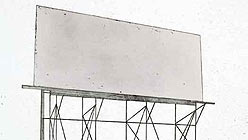The group exhibition Hard Edges for Hard Times is an impressive collection of prints curated by the well-loved Bay Area artist Tom Marioni. The show spans the decades of Crown Point Press’s history since the 1970s. Along the way, it makes some intriguing claims, both explicitly and unintentionally, about the relationship between medium, subject, and tone and about greater trends in the art world — even the real world.
In the exhibition’s quirky press release, Marioni explains his basic premise: “In economic hard times we see a lot of art about theory and philosophy, and in economic good times we see more art that’s about money.” I would be fascinated to see what “art that’s about money” looks like, but that’s beside the point. It’s clear from this selection of work that art focused on “theory and philosophy” (at least the kind that Marioni is drawn to) has a very specific look and feel to it. These prints could all be described as cerebral and introspective; they ask the viewer to come to them and don’t really offer to do the same in return.
A very literal example is Ed Ruscha’s etching Your Space #1 (2006), a depiction of a blank billboard that begs to be populated with its viewers’ projections. The work in Hard Edges is almost uniformly abstract or very sparse, paying homage to the hallmark movements of the decades it spans such as abstract expressionism, minimalism, and conceptual art of the ’60s and ’70s. Marioni has included heavy-hitters like Ruscha, Vito Acconci, Sol LeWitt, John Cage, and Mel Bochner, whose contributions are contemplative but playful. It seems that “theory and philosophy” aren’t purely somber subjects, contrary to what the exhibition’s title suggests.
What’s particularly intriguing about this show is the significance of its venue in relation to its premise. Crown Point Press, the publisher of each print on view, has endured for years as an important printmaking studio, helping to establish the Bay Area as a training ground for great printmakers. The significance of Crown Point Press points to two larger phenomena: the importance of craft in creating these exquisite prints and, on a grander scale, the role of craft in the contemporary art world.
Arguably, there is a parallel development between the economic climate of the past several decades and the relationship between “fine art” and “craft.” The mounting tension between art and craft cannot be overstated, and many artists have fought to marry or at least equalize the two in the eyes of museums, galleries, art schools, and art practitioners. The continuing existence of Crown Point Press, among many other studios and schools, signifies the continuing strength of craft within contemporary artistic practice, and an exhibition like this one underscores how much of the legacy of post-war art is owed to the medium of printmaking. To artists associated with minimalism and conceptual art, the printing press could manifest key tenets of these movements: it could flatten blocks of color, opening up new possibilities for abstraction — as it has in Brice’s Marden’s aquatint etching Image D from Five Plates (1973), for example. The medium also allowed artists to play with the idea of multiplicity, both in a single work and in a series, and it provided a platform for “democratizing” art by working in editions. This last ideal referred both to disseminating prints more easily on an international scale and selling them at a drastically lower price point than painting or sculpture. Finally, a studio like Crown Point Press, where artists work with a master printer, allowed conceptual artists to make technically adept work while removing the preciousness of the artist’s hand from its production.




